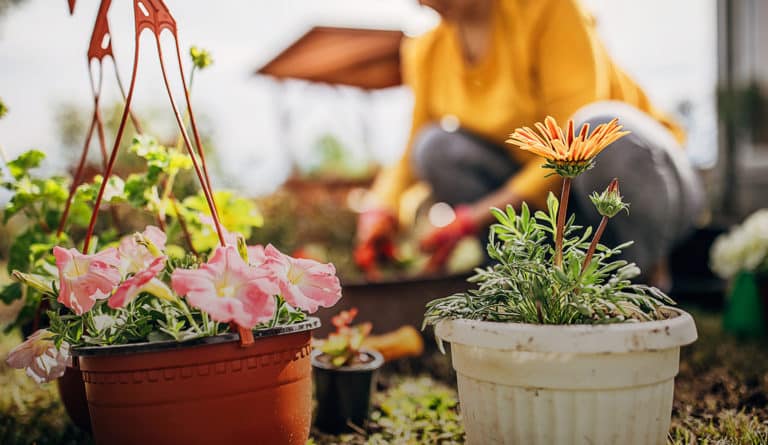
petunias
aka Petunia × atkinsiana
So many gorgeous, trumpet shaped flowers! And they come in practically every colour but blue. They were practically made for hanging baskets, but also look great in window boxes and garden beds.
variations
Grandiflora, multiflora, milliflora, and spreading (wave)
light
full sun
Appreciate 6 to 8 hours of full sun.
water + feeding
not too thirsty
Petunias are from South America and handle the heat well. Watering once a week is usually enough, but you may need to increase watering during prolonged dry spells. This is especially true of spreading varieties of Petunias, and ones planted in baskets or planters. Give a through soak when you do water. Shallow watering causes shallow roots.
toxic
non-toxic
Non-toxic to cats and dogs
size
they vary
Floribundas – blooms are 2½ to 3 inches across. Grandifloras – 8 to 12 inches tall with large 4 to 5 inch blooms Millifloras – 8 inches tall and 8 inches wide, with tiny 1 inch blooms Multifloras – early bloomer with 1½ to 2 inch flowers
pro tip
Buy in flats
Forget growing from seeds. Buy a whole flat from your local nursery. Look for short and compact plants that aren’t blooming and haven’t grown leggy.
fun fact
cousins to tobacco
Petunias resemble tobacco plants. In fact, they got their name from the Brazilian word for tobacco, “petun”. Petunias can even be crossed with tobacco plants, but we don’t suggest smoking them. For so many reasons.


beyond the basics
-
soil & potting
Petunias like moderately rich well-draining soil. They don’t like to sit in the wet. Amend poor soil with compost or peat moss prior to planting. When planting petunias in containers, use a well-draining potting mix like Miracle-Gro® Moisture Control Potting Mix.
-
companion planting
Fast growing and mega-blooming, Petunias have a tendency to bury their planter and basket neighbours in an avalanche of flowers! Some plants can keep up though, like golden creeping Jenny and New Guinea Impatiens.
-
blooms
Flowers, flowers and more flowers! That’s what Petunias are all about. They are 6 main varieties of Petunias: Cascadia, Grandiflora, Milliflora, Multiflora, Supertina and Wave. Each have a preferred growing style but the one thing they have in common is nonstop blossoming.
-
pest control
Petunias don’t normally suffer from pests or disease, but slugs and aphids are occasional problems. You can help prevent disease by avoiding wetting the leaves when you water. Get that water right in the soil.

troubleshooting
-
why does my plant have powdery spots on the leaves?
It’s mildew. Probably due to overcrowding, which is preventing proper air flow around your plants. Prune back some foliage or even replant to space things out. Cut back on watering until the problem improves.
-
why do I have rotten stems and or roots?
Poor drainage, overwatering or both. You may also notice wilted leaves. Troubleshoot your drainage and/or water less. If things are really rotted out, and it’s early in the season, consider starting over.
-
what do discoloured blooms or leaves mean?
It’s likely Botrytis Blight which is caused by overly wet soil. Cease watering until the soil dries, at least the top inch. Prune away affected leaves and blooms. Clear out any wet debris that’s adding to the problem. This problem usually goes away when you take these steps and dry things out.
-
what are these yellow spots?
It could be a virus and sadly there is no cure. Prune away all affected areas and clean your pruning tools thoroughly to avoid spreading the virus. If a plant is totally affected, yank it and put it well away in a yard waste bag. Also check under the leaves for pests, they could be causing the spread. Get those pests with a safe pesticide like Ortho® Bug B Gon® ECO Insecticidal Soap.
-
why is my Petunia so sad and wilted?
If it isn’t extreme under-watering. If the wilt isn’t obviously due to bone-dry soil conditions, it could be Verticillium Wilt. There is no cure. Sigh. Pull the wilted plants, dispose of them and start over. We suggest individual pots to prevent a repeat.



